Lady Royal Aristocrat is looking a lot better after her key top reattachment surgery, and the J-B Weld Steelstik bonds are holding great after a few days of typing – I need to get some neighborhood kids to put her through her paces.
She’s looking good, but has/had a few lingering issues.
Sticky Ribbon Vibrator
First off: I couldn’t see a thing as I typed because my ribbon carrier wasn’t returning to its lowest position with each stroke. The ribbon hid all the typed text.
My online research indicated that the sticky ribbon vibrator problem was probably due to either dirt or binding or both.
I cleaned the ribbon vibrator carefully, scrubbing with denatured alcohol and using a penetrating lubricant (PB Blaster). Things looked cleaner and the ribbon guide began to flicker and move up and down as I typed. Upper case typing wasn’t a problem because the entire basket moved down with shifting, but lower case typing was still obscured by the high riding ribbon.
I read that gentle bending of the ribbon guide could free it so it would move smoothly up and down, but what to bend and which way to bend it?
Let’s Go to TWDB
Because I am a member of Typewriter Database, I can access its documents library. I get a lot out of the manuals. Knowing the name and function of parts helps me a lot; otherwise, I’m just staring at a lot of small, mysterious metal pieces.
One interesting manual that I seem to have passed over in the past is called D. E. Fox Typewriter Repair Manual, 1950. Perhaps I had foolishly assumed that it was a repair manual for Fox typewriters. No – it isn’t. It covers standard and portable Underwood, Remington, LC Smith, Smith-Corona and Royal typewriters.
In the Royal portable section about the ribbon vibrator it says:
“The Ribbon Carrier (Vibrator) must operate freely. Examine the ribbon guiding wings of Ribbon Carrier (1) to make sure that they are not fitting too closely to Type Bar Guide (2)”
D. E. Fox Typewriter Repair Manual, 1950, TWDB Documents Library
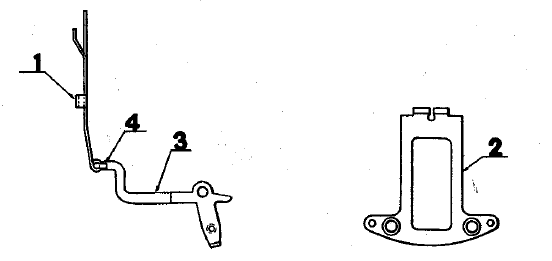
image: D. E. Fox Typewriter Repair Manual, 1950; TWDB
Those “guiding wings” were fitting a little too closely to my type bar guide on my machine. Very gently pinching the ribbon carrier forks together at the top loosened the “guiding wings” grip on the type bar guide and the parts of the ribbon vibrator mechanism began to slide freely.
Perhaps at some point in its life the typewriter had take a hard hit to the top, splaying the ribbon vibrator forks open and causing the binding.
Success: the ribbon moved properly out of the way with each key stroke and I could see what I typed.
Off the Rails: Royal Margin of Error
I have heard tell of the Royal typewriters’ reputation for erratic left margin behavior, and now I get to experience the Royal “soft margin” first-hand:
It is said to be fixable.
According to a Yahoo Typewriter Group post:
“The soft left margin was easily adjustable with the margin stop screw.”
And according Typewriter Maintenance, TM 37-305, 1944:
“Margin Stop Banking Screws may be made accessible by moving carriage to the extreme right or left, whichever is necessary, disconnecting Bail Lift Screws, and swinging Margin Release Bails back out of position.”
Ok – I just need to find that easily adjustable margin stop screw. I am still on the hunt for that.
A Little Letter Piling
I’ll admit it. I am terrible typist. I am a two-fingered keyboard hunt and pecker with an inconsistent slamming flail that drives just about anybody watching or hearing me nuts. I type like a high-energy ten year-old kid set loose on a typewriter at Goodwill. You would not trust me with your fine collectible typewriters.
To the point: seven of my typewriters put up with me and my ways. Big Betty the KMC, Olive Dammit the Oliver, Corona McDraggle, Posh Spice, Camper Van Pancake the Skyriter, Mrs. Hudson the Torpedo, Marge the SG3 – they all tolerate my touch.
- Big Betty the KMC
- Olive Dammit
- Corona McDraggle
- Posh Spice
- Camper Van Pancake
- Mrs. Hudson
- Marge
- Lady Royal Aristocrat
Lady Royal Aristocrat – not so much. If I type too weird and too fast on the Aristocrat, I get letter piling. It trips, the door opens and then there’s a drunken pile of two letters who snuck in. If I type like a normal person, everything is fine. However, as soon as I show a little “flare”, I will get the occasional letter piling. None of my other typewriters do this to me. Is this yet another Royal hallmark or something unique to my machine?
It doesn’t bother me too much – it’s a smallish quibble. I still love Lady Royal Aristocrat.
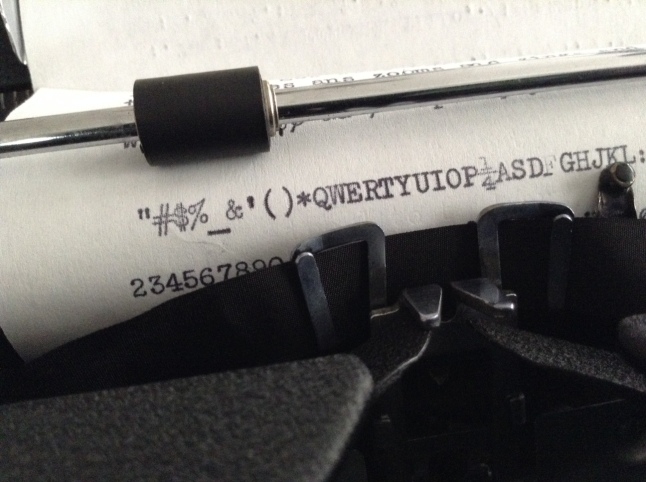
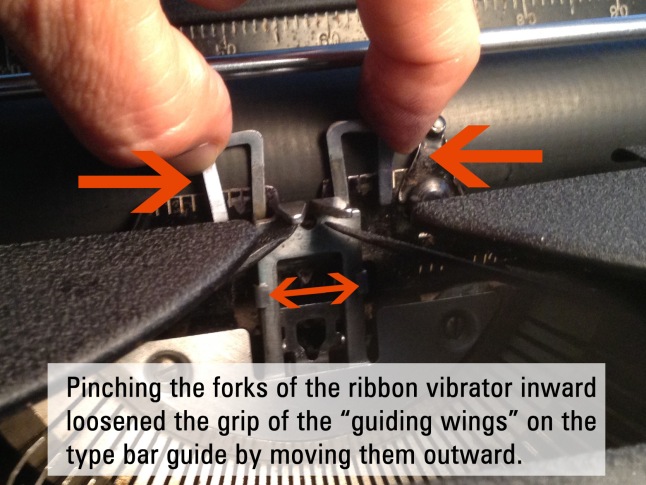


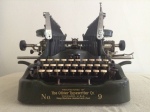
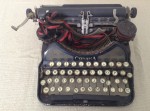

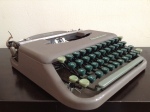
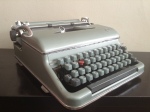

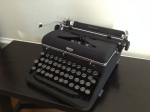
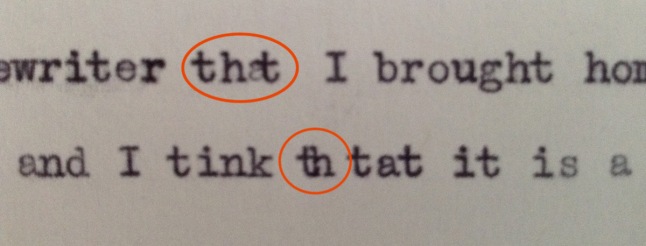
I think you can adjust the trip point for the escapement and do an extra turn on the motor to improve the piling problems. Not sure how on a Royal, but it’s fairly easy on an SCM.
LikeLike
I’ll increase tension on the mainspring and see if that makes a difference. Regarding adjusting the trip point for the escapement, I want type bars to trip the escapement closer to the platen, right?
LikeLike
hmmn, I would think farther away. I believe the trip happens *before* the slug hits the platen, so if you’re piling, you want to give the escapement a bit more time to advance before the slug hits. You can check for sure by just lightly pressing a key until the key bar goes halfway up, then grab it and guide it very slowly to the impact point.You’ll feel the escapement trip somewhere about a quarter inch or so from the platen. Don’t know offhand what the adjustment point is, but the manuals should have the procedure somewhere.
LikeLike
DE Fox’s section on Royal portables says that the escapement should trip when the typebar is about 3/8″ from the platen. It says that by forming the “Trip Arm” I can make adjustments to the escapement trip. I am going to increase mainspring tension first (and hope that solves the problem) before I start fiddling with the trip arm.
LikeLike
Every single post-30’s Royal portable I own, used to own, or will soon own piles letters. They do it no matter what condition they’re in. It’s quite frustrating, but very very common.
LikeLike
Interesting! So it may be a Royal quirk. I am trying to nail down the cause and a fix.
LikeLike
Escapements do differ in design (especially the Noiseless Portable!), afaik the Royal trips/primes just before striking, but only the return movement of the typebar releases carriage for indexing.
Letter piling could also be because of some dirt/oil/clogging the escapement mechanism or the carriage rails.
That having been said – machines do have their own rhythm and speed at which they (are tuned to) work well. For e.g. the RP2 I’ve now set the mainspring fairly weak to have a ‘slow’ machine but with a very light carriage return.
LikeLike
The typewriter was very, very dirty when I got her and there may be residual dirt/oil/gunk in the escapement or rails. I will do a repeat clean and see if that improves the letter piling. Increasing tension on the mainspring did not seem to affect letter piling. I am hesitant to adjust the escapement trip arm as the typewriter is currently typing beautifully but for the rare letter piling.
LikeLike
No amount of mainspring tension will fix your “letter-piling”. As Ted says, it is the escapement trip that is critical. I would concentrate on that. By the way, Mary, did you check where the trip occurred? If you get the trip right than you will be able to type with your usual flair!
LikeLike
It is tripping way-way out with slugs about 3/4″ from the platen. I am going to experiment with forming the trip arm to adjust the trip so it occurs with slugs a bit closer to the platen.
LikeLike
I agree with what the others have said. I type slower on my Royals that other portables. Another problem I’ve noticed with my Deluxe and Arrow is that on the black ribbon setting, sometimes the ribbon won’t be raised high enough to make a clear imprint on the page. I guess it’s because of the way the ribbon is put on the vibrator.
LikeLike
I am starting to think that my letter piling may be fixable with a second thorough cleaning and a minor adjustment. The erratic left margin may also respond to a thorough cleaning. In fact, your low-rising ribbon vibrator may improve with gentle cleaning and lubrication.
LikeLike
on my 1966 Royal Safari portable, I found the rigid dog was out of alignment with the escapement wheel where the loose dog was holding it. Whenever I pressed a key or the space bar, it was forcibly backing the escapement wheel before it spaced forward. I bent a tab at the front of the escapement wheel. This moved the loose dog’s position more in alignment with the rigid dog. Now, the spacing is softer, and in fact, the escapement wheel goes forward about 1/16″ forward when the space bar is pressed. On this typewriter, the rigid dog is fitted with a tiny little roller wheel that engages the escapement wheel. I lubricated this, cleaned and oiled the escapement mechanism, and now this machine really scoots. Perhaps if I look into more of my Royal portables, I will probably need to lubricate these rollers.
LikeLike
I think I have a similar situation. The escapement trips very early, when the type slugs are 3/4″ away from the platen. According to the DE Fox manual (Royal Portables section), I can adjust the escapement trip by forming the trip arm forward. I am planning to do this but I am stymied by a rusty screw on the back panel. I can’t get the back panel off to access the trip arm because of that darn rusty screw. I pull the Aristocrat out once in a while and try to remove the screw. I imagine it will need repeated applications of a penetrating oil to come out. I just got some new hollow ground screwdrivers that may do the trick. I also think that thorough cleaning and lubrication of the escapement is in order once I have access via the back panel.
LikeLike
Seems like a knowledgeable group. Seems with as many of these they made the erratic left margin and the letter pilling would have been sorted out by know.
Thanks
LikeLike
The more of these Royals that come through my hands, the more I think that the way their mechanics are configured makes them more sensitive to dirt and gunk. I have found that a thorough cleaning often takes care of the soft left margin and reduces letter piling.
LikeLike